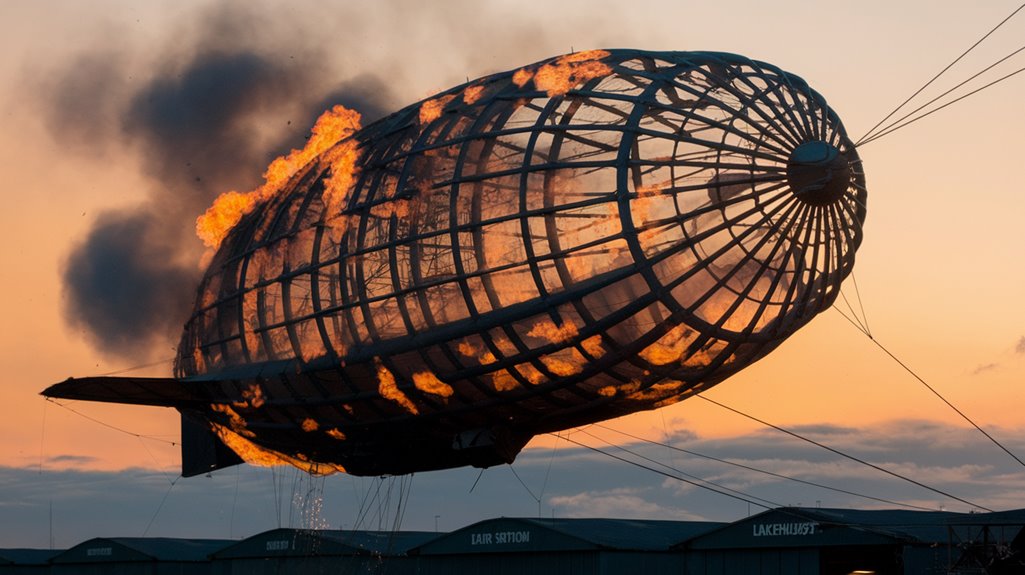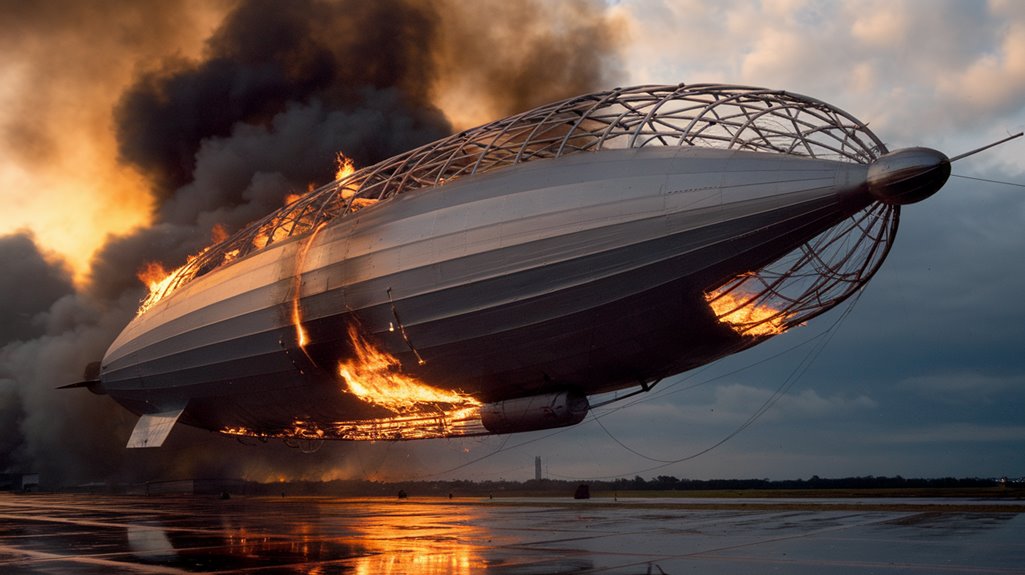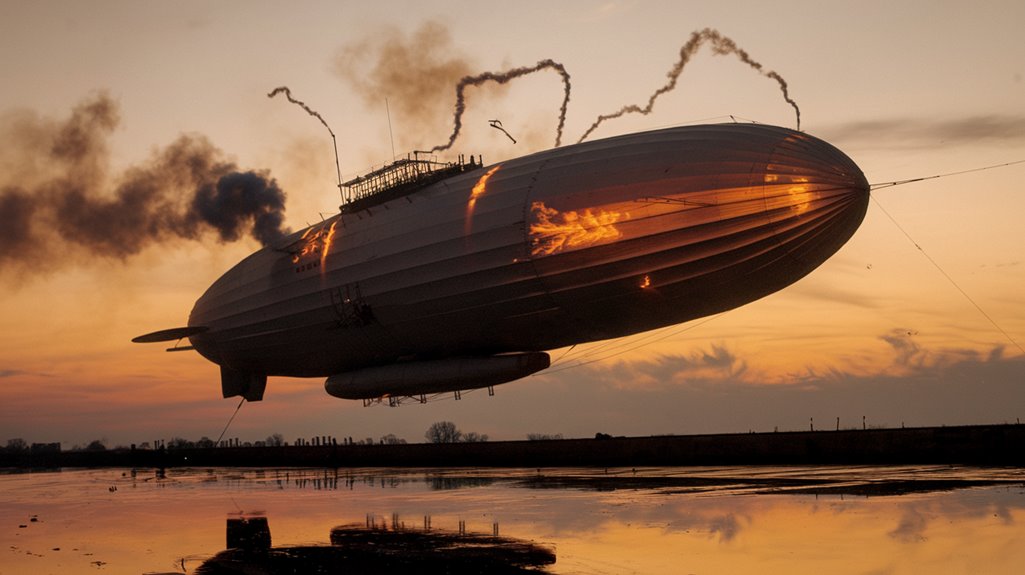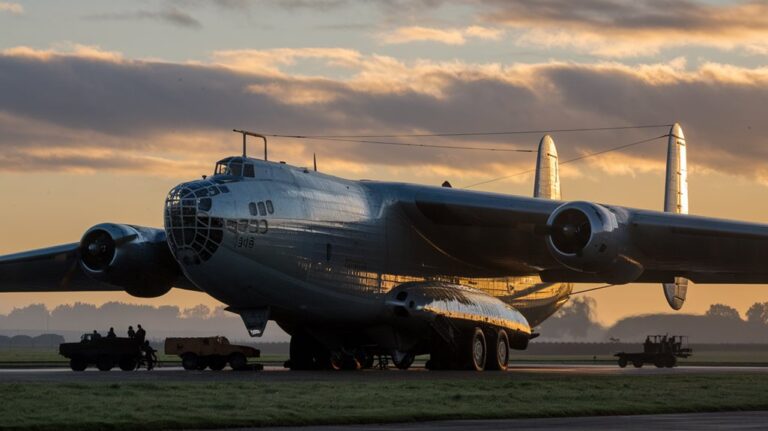The Hindenburg Disaster: How One Airship Changed the Future
You've probably seen the iconic black-and-white footage: a massive silver airship erupting into flames as a reporter's voice breaks with emotion. The Hindenburg disaster wasn't just a tragic accident – it was the moment that transformed aviation forever. While the 97 passengers and crew members aboard that day couldn't have anticipated it, their fateful journey would write the final chapter of the passenger airship era and set the stage for modern air travel as it exists today.
The Dawn of Passenger Airships: A Golden Age of Travel
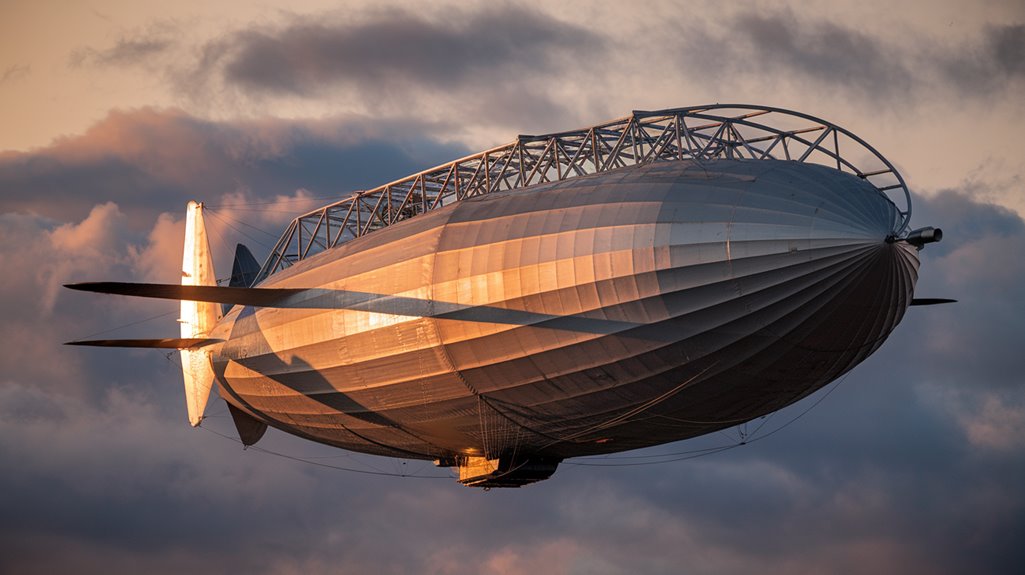
As World War I drew to a close, the once-military zeppelins found an unexpected new purpose in luxury travel.
You'd find yourself stepping into a world of unparalleled airship luxury aboard vessels like the Graf Zeppelin and the massive Hindenburg, which offered amenities that rivaled the finest ocean liners of the day.
These floating palaces of the sky transformed long-distance travel experiences during the 1920s and 1930s.
You could dine in elegant restaurants, enjoy live music in dedicated entertainment rooms, and cross the Atlantic in record time – just 43 hours on the Hindenburg's fastest journey.
The Hindenburg's remarkable 804-foot length made it longer than both the Titanic and a Boeing 747, creating an unprecedented scale of luxury air travel.
A one-way ticket aboard the Hindenburg cost passengers $400 in 1936, making it a significantly more expensive option compared to traditional ocean liner travel.
Nations worldwide embraced this new form of transportation, with Germany leading the charge in commercial flights.
The Graf Zeppelin's regular routes between Germany and South America showcased the impressive capabilities of these engineering marvels.
Inside the LZ-129: Engineering Marvel of the Skies
A technological masterpiece of its time, the LZ-129 Hindenburg stretched an impressive 803 feet in length – nearly four times the wingspan of a modern Boeing 747.
You'd find design innovations throughout this floating marvel, from its water recovery system that captured engine exhaust to replace ballast, to passenger rooms integrated within the hull to reduce drag. The exterior was covered with cotton cloth varnished to protect against the elements. The airship's sixteen gas cells were separated by bulkheads to contain the lifting hydrogen.
Inside, you'd discover two main decks: the upper "A" deck housed luxurious passenger quarters, a dining room, and lounges, while the lower "B" deck contained crew areas and a smoking room.
The airship's safety measures included high-strength duralumin frames and specialized engine pods.
Four powerful Daimler-Benz diesel engines propelled this engineering wonder through the skies at speeds up to 84 mph, while carrying up to 72 passengers in unprecedented comfort.
The Fatal Flight: A Minute-by-Minute Account
The Hindenburg's final moments began with a seemingly routine landing approach at 7:00 p.m. on May 6, 1937.
As you'd imagine the scene, Captain Pruss maneuvered the massive airship at 650 feet, executing sharp turns while valving gas to slow down.
The duralumin structure creaked under the strain of the maneuvers.
The airship had completed ten successful trips to the United States in 1936 before this fateful journey.
By 7:21 p.m., crew members dropped the mooring lines at 295 feet, and ground crews scrambled to secure them in the light rain.
Then, at 7:25 p.m., your peaceful evening view would've transformed into horror.
According to eyewitness accounts, flames erupted and engulfed the airship in just 37 seconds.
There was no time for an orderly fire escape.
The Hindenburg's stern imploded, its back broke, and its bow lurched upward before crashing.
In those terrifying moments, 35 passengers and crew members, plus one ground crewman, lost their lives.
Theories Behind the Catastrophe
While the final moments of the Hindenburg disaster were well-documented, questions about its cause sparked decades of investigation and debate.
Modern research points to static discharge as the most likely culprit. As the airship passed through a weather front, its fabric skin, separated from the metal frame by non-conductive cords, accumulated an electrical charge that eventually sparked and ignited leaking hydrogen.
Though sabotage theories emerged due to the political climate of the time, investigators found no evidence of bombs or intentional tampering. The disaster resulted in thirty-five fatalities, marking a tragic end to what had been considered a luxurious mode of transportation.
Other explanations, such as engine backfire and lightning strikes, have been largely dismissed. The consensus among airship historians is clear: a perfect storm of natural factors – the static discharge, weather conditions, and the use of hydrogen instead of helium – led to this devastating accident.
The entire catastrophe lasted just 32 seconds from ignition, yet it was enough to end the era of passenger airship travel.
Following its catastrophic destruction in 1937, the Hindenburg disaster marked a definitive end to commercial passenger airship travel.
While the Hindenburg once represented the pinnacle of luxury transportation, offering you an unmatched experience in the skies, its tragic fate forever changed aviation's trajectory.
The disaster didn't just end the world's first airline – it reshaped the entire future of air travel.
Before its demise, the airship offered passengers fine dining and entertainment during the fastest transatlantic crossings of its time.
Despite the lingering airship nostalgia for this elegant mode of transportation, the incident sparked vital safety advancements in aviation.
DELAG, founded as the world's first airline in 1909, had revolutionized travel before the tragic accident changed everything.
You'll find that the aftermath prompted a decisive shift toward conventional aircraft, which proved safer and more economical.
The Hindenburg's legacy serves as both a cautionary tale about technological risks and a catalyst that accelerated the aviation industry's evolution toward modern air travel.

